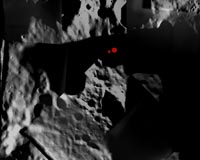 |
Science@NASA Huntsville AL (SPX) Oct 08, 2009 NASA is figuring out how to make water from moondust. Sounds like magic? "No magic--" says Ed Ethridge of NASA's Marshall Space Flight Center "-- just microwaves. We're showing how microwaves can extract water from moondust by heating it from the inside out." The recent discovery of water on the Moon's surface has inspired researchers like Ethridge to rev up the development of technologies to capture it. Some of them believe the small amounts of frozen water mixed in lunar topsoil are just the tip of the iceberg.1 If so, Ethridge has figured out a way to retrieve it. "We believe we can use microwave heating to cause the water ice in a lunar permafrost layer to sublimate - that is, turn into water vapor. The water vapor can be collected and then condensed into liquid water." "Best of all, microwave extraction can be done on the spot. And it requires no excavation - no heavy equipment for drilling into the hard-frozen lunar surface." He calls his first mining experiment the "Moon in a bottle." "We filled a bottle with simulated lunar permafrost [fake moondust containing water ice] and heated it in a microwave oven. The microwaves heated the simulant enough to extract water, even though the soil was as cold as it would be on the Moon." At least 95 percent of the water added to the simulant was extracted (vaporized out of the soil) with 2 minutes of microwaving. "And we were able to capture 99 percent of the vaporized water in our cold trap," says collaborator Bill Kaukler of the University of Alabama-Huntsville. "It works." Then Ethridge and his team moved beyond the oven to beaming microwaves into the simulant - the way it would have to be done on the Moon. The beamed microwaves were absorbed into the soil and heated it sufficiently to extract water. "This was an important demonstration. We had to make sure the microwaves wouldn't reflect off the surface," Ethridge explains. "It worked beautifully." What's next? "We've asked for some genuine soil from the Apollo missions," says Ethridge. "We want to test the real thing and calculate how fast the water vapor will come out. That's an important piece of information." "There are other things we need to know, like how much ice is at the poles, how deep it is, where it is - is it only in the craters or is it everywhere?" This Friday morning, Oct. 9th, LCROSS (the Lunar Crater Observation and Sensing Satellite) could answer some of the questions about moonwater when it plunges into crater Cabeus at the lunar south pole to unearth signs of H2O. If ample water ice does exist on the Moon, how would lunar residents collect it? "They'd have to beam microwaves into the soil and collect the water vapor in a cold trap," he explains. "We want to build a prototype water prospecting experiment to demonstrate the technique we'd like to see used in a lunar water mining facility." He stops talking, looks up, and smiles. "I'd be willing to go up and set up the first Lunar Water Works - if they'd let me." Share This Article With Planet Earth
Related Links Science@NASA Mars News and Information at MarsDaily.com Lunar Dreams and more
 Updated SMART-1 Image Of New Target For LCROSS Impact
Updated SMART-1 Image Of New Target For LCROSS ImpactParis, France (ESA) Oct 08, 2009 The European Space Agency's SMART-1 team has released an updated image of the future impact site of NASA's Lunar Crater Observation and Sensing Satellite (LCROSS), after the LCROSS team announced a new target last week. LCROSS will search for water ice on the Moon by making two impacts into a crater named Cabeus at the lunar South Pole. The impacts are scheduled for 11:31:19 UTC and 11:35:45 UTC ... read more |
|
| The content herein, unless otherwise known to be public domain, are Copyright 1995-2009 - SpaceDaily. AFP and UPI Wire Stories are copyright Agence France-Presse and United Press International. ESA Portal Reports are copyright European Space Agency. All NASA sourced material is public domain. Additional copyrights may apply in whole or part to other bona fide parties. Advertising does not imply endorsement,agreement or approval of any opinions, statements or information provided by SpaceDaily on any Web page published or hosted by SpaceDaily. Privacy Statement |